
Pseudopanax arboreus or five finger, is a New Zealand native tree belonging to the family Araliaceae. It is one of New Zealand's more common native trees, being found widely in bush, scrub and gardens throughout both islands. The compound leaves with five to seven leaflets, hence the common name, are very characteristic of the tree and easily recognized.
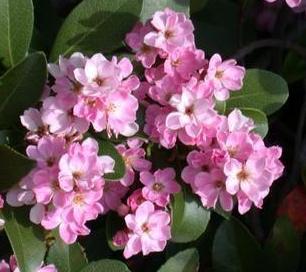
Rhaphiolepis indica, the Indian hawthorn, India hawthorn or Hong Kong hawthorn is an evergreen shrub in the family Rosaceae.

Cynometra beddomei is a species of tree in the family Fabaceae. It was described from a single tree in the Kerala Western Ghats of India. In 1998 it was declared extinct as it had never been seen again since 1870.

Anacolosa densiflora is a species of plant in the Olacaceae family. Currently, it is an endangered species that is endemic to India.

Vateria indica, the white dammar, is a species of tree in the family Dipterocarpaceae. It is endemic to the Western Ghats mountains in India. It is threatened by habitat loss. It is a large canopy or emergent tree frequent in tropical wet evergreen forests of the low and mid-elevations.

Cestrum diurnum is a species of Cestrum, native to the West Indies. Common names include day-blooming cestrum, day-blooming jessamine, and day-blooming jasmine. Also known as Din ka Raja, in Hindi. The scent of this quick-growing and evergreen woody shrub, often used for screens and borders, is released by day. Cestrum diurnum is easily propagated from the seed, which it produces in abundance.
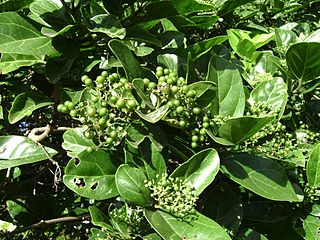
Premna serratifolia is a small tree/shrub in the family Lamiaceae. It flowers and fruits between May and November. During flowering season, it attracts a large number of butterflies and bees. Synonyms of Premna serratifolia Linn. include P. corymbosa Merr., P. integrifolia L. and P. obtusifolia R. Br.).
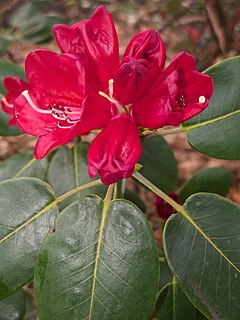
Rhododendron thomsonii (半圆叶杜鹃) is a rhododendron species native to northern India, Bhutan, Nepal, Sikkim, and southern Xizang in China, where it grows at altitudes of 3,000–4,000 m (9,800–13,100 ft). It is a shrub that grows to 2–4 m in height, with leathery leaves that are oblong-elliptic to ovate or orbicular to obovate, 3–7 by 2–6 cm in size. Flowers are red.
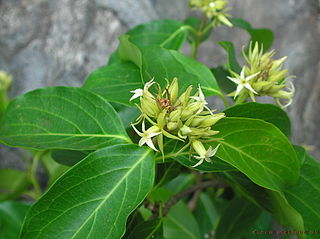
Aganosma cymosa is a liana that can grow up to 10 m (33 ft) in length, pale brownish tomentose. Leaf-stalks are 1–2 cm (0.4–0.8 in), leaf blade broadly ovate or orbicular, 5–16 cm (2.0–6.3 in) by 4–12 cm (1.6–4.7 in), base rounded or obtuse, apex acuminate or obtuse, rarely retuse, lateral veins eight to ten pairs. Flowers are borne in many-flowered clusters at branch ends, which are carried on stalks up to 6 cm (2.4 in). Bracts and bracteoles are very narrowly elliptic, about 1 cm (0.4 in) long. Flower-stalks are about 5 mm (0.2 in). Calyx with several glands inside margin of sepals; sepals very narrowly elliptic, about 1 cm (0.4 in), pubescent on both surfaces. Flowers are white, minutely tomentose outside, glabrous at throat; tube shorter than sepals, 6–7 mm (0.2–0.3 in); lobes oblong, as long as tube. Disc longer than ovary. Ovary pubescent at apex. Follicles 2, cylindric, to 30 cm (12 in) by 0.8–1.2 cm (0.3–0.5 in), yellow hirsute. Seeds oblong, 1–2 cm (0.4–0.8 in) by about 5 mm (0.2 in), coma 2–4.5 cm (0.8–1.8 in). It is native to China, Bangladesh, India, Sri Lanka, and Indochina.
Oplismenus thwaitesii is a flowering plant that is endemic to India.
Diospyros atrata is a tree in the Ebony family. It commonly grows to 25 metres tall. The plant can be seen in subcanopy trees in medium elevation wet evergreen forests between 1000 and 1400 m in Western Ghats- South Sahyadri, Kerala, and Tamil Nadu in India and from Kandy district in Sri Lanka

Rhododendron grande is a rhododendron species with a native range from eastern Nepal, Sikkim, Bhutan into central Arunachal Pradesh and southern Tibet. It grows at altitudes of 2100–3200 meters and reaches 6–15 meters in height in mixed forests. Flowers vary from cream to yellow to pink, spotted with a blotch on the top petal.

Ficus tsjahela is a fig tree from the family Moraceae which is found in peninsular India and Sri Lanka. It is commonly known as the kaaral in Malayalam, kal-aal in Tamil and boviyamara in Kannada.

Vanda wightii is a species of orchid from southern India and Sri Lanka. For some time it was thought to be extinct after being described in 1849. The species was however rediscovered and it is now known from India. It is closely related to Vanda thwaitesii. The species was named by Reichenback after the botanist and collector Robert Wight. 1.
Atalantia simplicifolia is a species of plants in the family Rutaceae. It can be considered as shrub or small tree with average height up to 5 m.

Bhesa indica is a flowering plant tree species in the Centroplacaceae family. It is distributed along the tropical wet evergreen forests of the Western Ghats of India. It is considered synonymous with Bhesa paniculata by some authors.
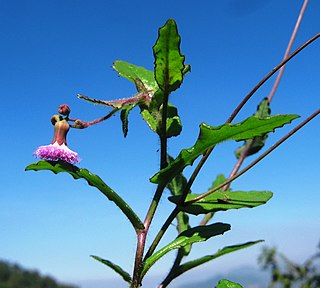
Emilia reddyi is a herbaceous plant species belonging to the family of Asteraceae found from Eastern Ghats, India.

Ficus amplissima, also known as the Indian Bat tree, Indian Bat fig, Pimpri, Pipri (Piparee), Pipali or Bilibasari mara is a tree species of flowering plants that belongs to Moraceae, the fig or mulberry family. It is native to Central and southern Peninsular India, Sri Lanka and Maldives, having a significant distribution throughout Western Ghats of India. It is most commonly planted to provide shade in coffee plantations due to its dense and wide foliage. The ripened figs attract many birds, especially during the spring.
Prunus pullei is a species of Prunus native to the highlands of New Guinea. It is a small tree, usually 15 m but reaching 24 m tall, with rough, lenticellate brown bark. At higher altitudes it takes on a more shrubby growth form.

Magnolia pterocarpa is a species of tree that grows in South Asia.




















